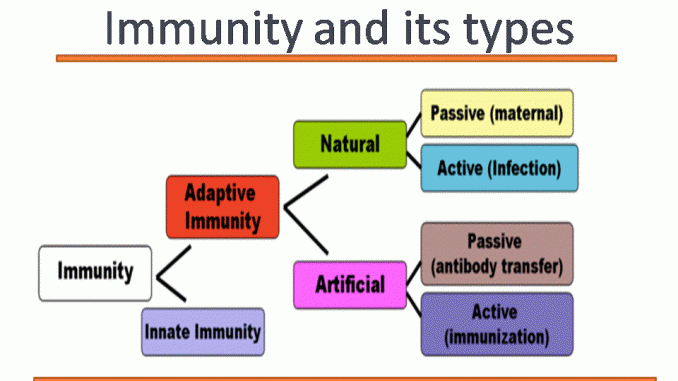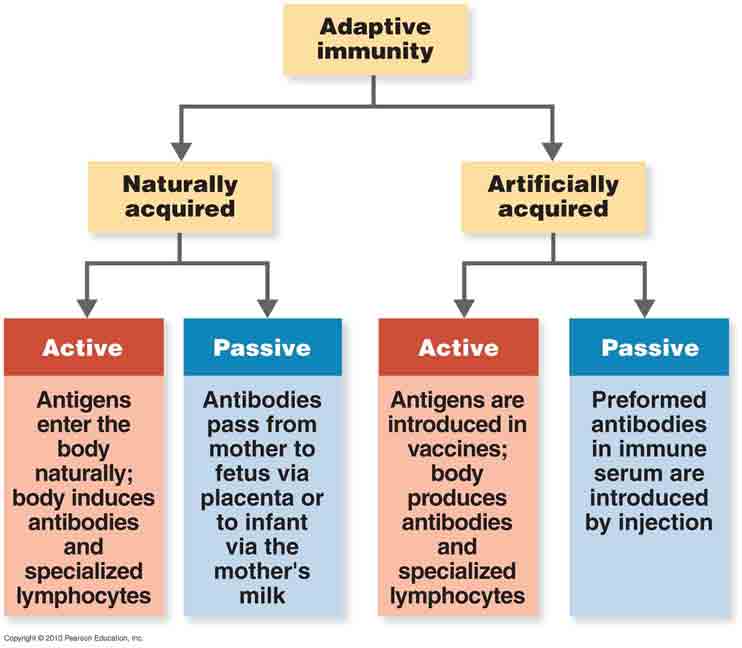The barrier to invasion by microbes involves. In what situation is one type preferred over the other.

Immunity And Its Types Innate And Acquired Immunity Online Biology Notes
Did you know that scientists are still working to create new types of vaccines.

. Types of Immunity Acquired Immunity. There are two types of immunity innate immunity and acquired immunity. Based on the type of immune cell acting against the antigens immunity can be classified into two types-Humoral immunity- the immunity which is mediated by antibodies produced by B-lymphocytes is called humoral immunity.
Active immunity can be acquired through natural immunity or vaccine-induced immunity. There are three types of immunity in humans called innate adaptive and passive. Innate immunity is present in all metazoans while adaptive immunity only occurs in vertebrates.
The Function of Innate Immunity. Innate immunity is non-specific type of defense. These specialized cells and parts of the immune system offer the body protection against disease.
The immune system has innate and adaptive components. The innate component of the immunity system involves the recognition of certain foreign non-self molecules to generate one of two types of innate immune responses. Protection is provided in the form of barriers in this type of immunity.
Active Immunity results when exposure to a disease organism triggers the immune system to produce antibodies to that disease. 8 rows Active Immunity. An Individuals own immune system produces the antibodies.
Innate or Natural immunity. When B cells encounter a pathogen they create memory cells in addition to antibodies. Everyone is born with innate or natural immunity a type of general protection.
We are all born with some level of immunity to invaders. Innate immunity consists of various barriers. Innate or natural immunity.
Innate immunity is provided by various components such as Skin mucus membrane Phagocytic cells etc. Sometimes the immune system attacks its own tissues and organs instead of the foreign agents. Active and Passive Immunity.
It is the resistance developed by individuals as a result of an antigenic stimulus exposure to antigen. Active immunity may be natural or artificial. Cell- mediated immunity- The immunity which is mediated by T- lymphocytes by directly attaching themselves to the antigens is called.
It creates a barrier against the. This protection is called immunity. Innate Natural or Nonspecific Immunity 2.
Innate immunity acts as first line of defense to particular microorganisms. The following points highlight the three main types of immunity present in humans. All of the above 2.
A vaccine is made up of the antigens. Highlight the different types of Immunity And Explain how Immunity is Related to Principles of Preventions 1. Acquired immunity or adaptive immunity is the immunity that our body acquires or gains over time.
There is also a passive immune response where antibodies come from an outside source instead of the individuals own plasma cells and are introduced into the host. The function of innate Immunity is very minimal. It is not specific it acts the same for all intruders entering the body.
Natural Acquired Active immunity. This is called immunity. Immunity is of two types-.
Active and passive immunity both serve this purpose but are different in how antibodies are created Active Immunity. All organisms possess some disease resistance ability that they have inherited from their parents or. The main types of immunity are witness immunity public officials immunity from liability sovereign immunity and diplomatic immunity.
The production of antibodies by plasma cells in response to an antigen is called active immunity and describes the hosts active response of the immune system to an infection or to a vaccination. There are two types of immunity. Immunity acquired due to infection is called natural active immunity.
Inflammatory responses and phagocytosis. There are four types of vaccines that are widely used against several diseases but there are new types of vaccines being developed that may be cheaper and provide longer immunity than. Here are 2 exciting examples.
Types of Immunity and Their Functions Innate Immunity. Acquired Specific or Adaptive Immunity 3. The immunity which occurs by birth is called innate immunity.
Innate immunity also called inborn immunity is inherited from parents and is present by birth. It also known as Adaptive immunity. In what situation is one type preferred over the other.
Acquired immunity is of two types Active and Passive. Recombinant vector vaccines platform-based vaccines act like a natural infection so theyre especially good at teaching the immune system. DNA vaccines are easy and inexpensive to makeand they produce strong long-term immunity.
For example the skin acts as a barrier to block germs from entering the. Humans have three types of immunity innate adaptive and passive. The future of vaccines.
Immunity with which an individual is born is called innate or natural immunity. Ad What Is the Common Functions of the Immune System. The first disease for which a successful vaccine was.
Science Anatomy and Physiology QA Library Explain the difference between the two types of immunity. A diagram showing the different types of active and passive immunity. Memory cells are a type of B cell produced following the primary infection that can recognize the pathogen.
1 Transactional immunity total immunity 2 Use and derivative use immunity Also known as total immunity transactional immunity provides a shield against any future charges based on any matter related to the testimony. Active immunity is more common in our bodies than passive immunity.

Acquired Immunity What Is It And How Do You Get It

What Is The Difference Between The Four Types Of Human Immunity Socratic

0 Comments